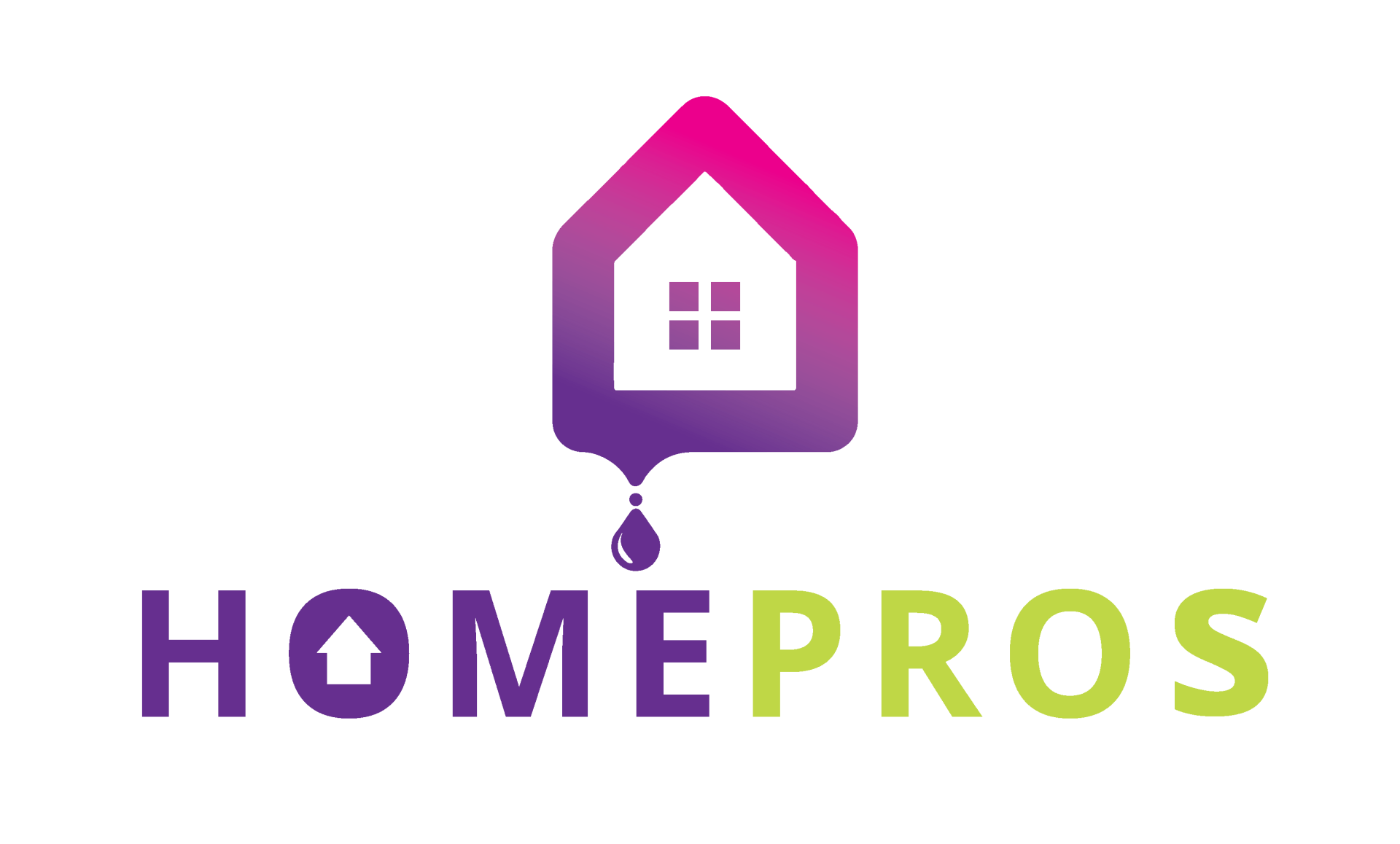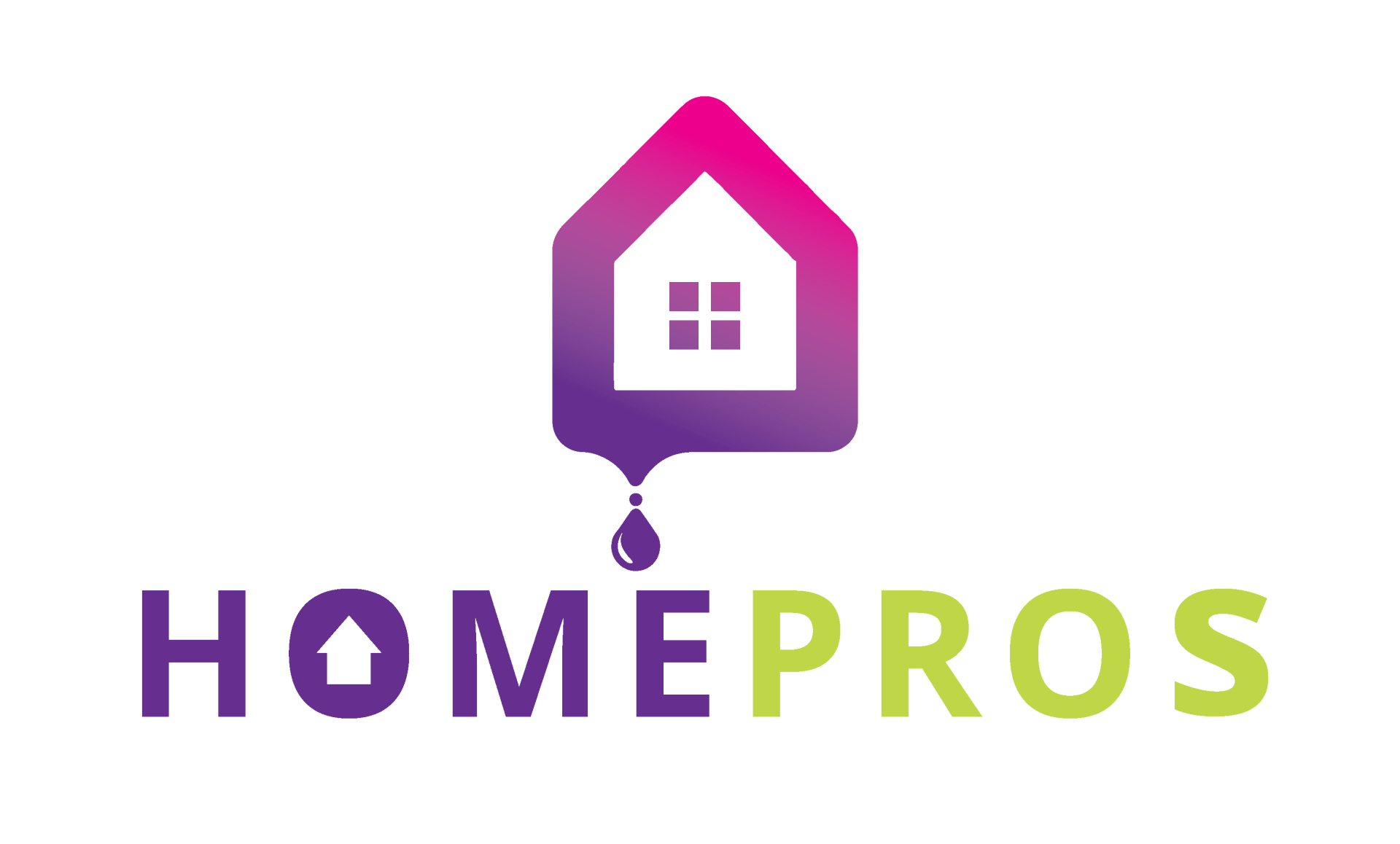How much will my Exterior Painting Project really cost me?

How much does it cost to paint the exterior of a house?
It is ultimately this question that we must answer for all our potential customers. Some folks don’t have a clue, while others do their darnedest to research the pricing of exterior paint jobs by searching online. Some folks just come up with a figure out of thin air.
Most people try to avoid having someone “actually look” at their house in person. It’s probably because they don’t want to deal with pushy salespeople or feel the obligation to follow through with the paint project.
The vast majority of shopping is now done online, so why not house painting as well? So perhaps that explains why there have been more websites recently trying to answer this very specific question every homeowner has.
It's no secret that home improvement sites such as HomeAdvisor, Angi, Homewyse, Forbes, This Old House, and NerdWallet are eager to push out a wide range of figures. However, the truth is that they are just reports based on regurgitated information. In essence, they gather information from one source and put their own spin on it to benefit the entire nation.
One thing you must keep in mind is that these types of websites tend to come up at the top of online searches because they invest a “ton” of money. The reason why? The company sells your data to painting companies as leads.
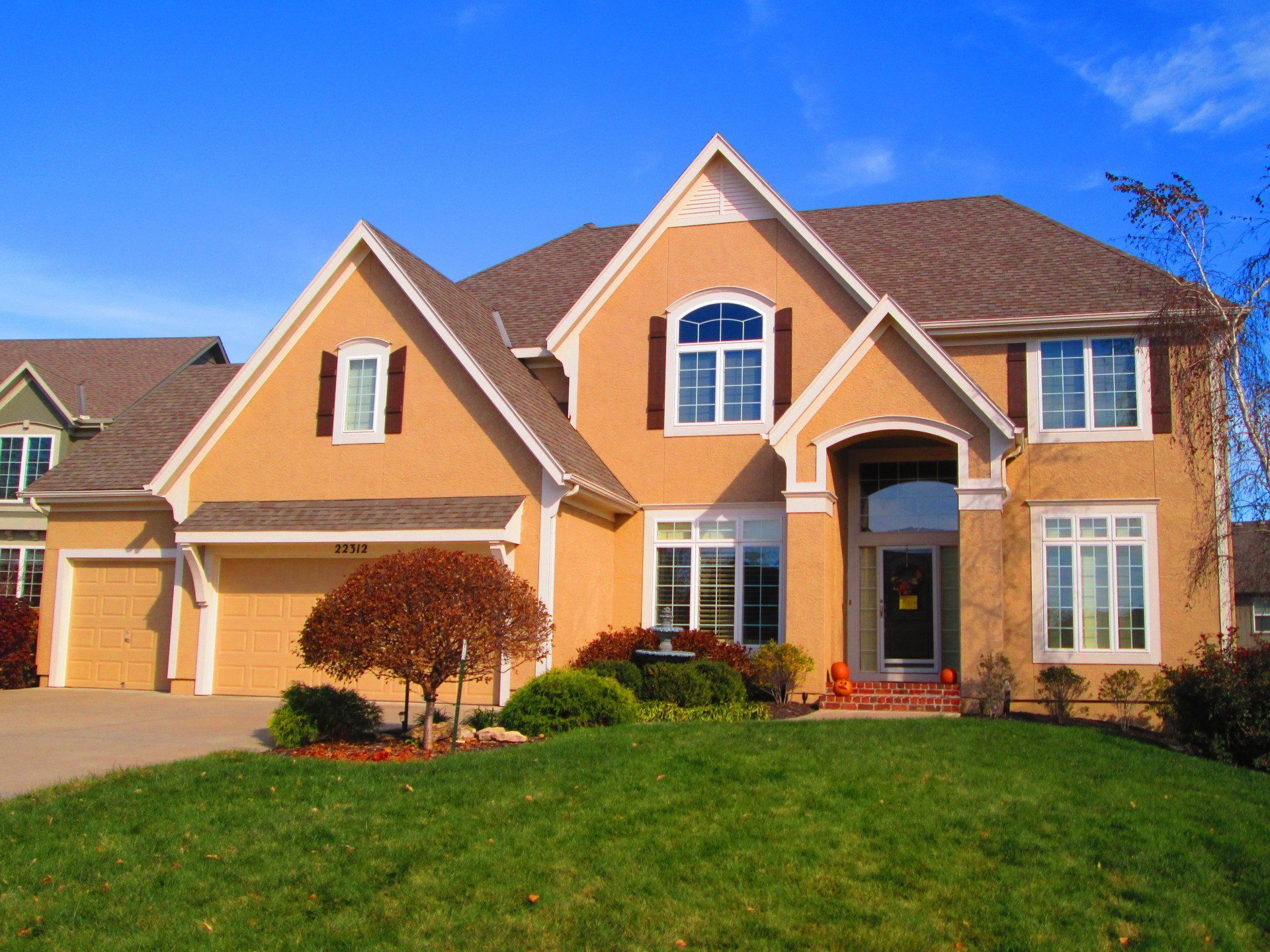
Why don’t painting companies publish their pricing?
Performing an online search and not finding the price of a product or service is incredibly frustrating for consumers. With all the advances in online search technology, finding the price for painting the outside of a house shouldn’t be difficult.
Unfortunately, the information isn't available because painting companies do not want consumers or competitors to know it. Their fear is that this pricing information will be used against them and that they will lose business as a result.
How are house painting costs typically calculated?
It all depends on what you want painted; the specific grade of paint you want to use; and what kind of support after the fact you want out of your contractor.
Below are the most common methodologies used in the industry today.
Square footage pricing
This method involves calculating the total square footage of the exterior surface to be painted and multiplying it by a per-square-foot cost.
Hourly pricing
This method involves charging a set hourly rate for the labor required to complete the project.
Time and materials pricing
This method involves charging for both the labor and materials used on the project, with costs for materials being based on actual costs incurred.
Fixed bid pricing
This method involves providing a fixed, lump-sum price for the entire project based on a detailed estimate of the work to be done and the materials required.
Cost plus pricing
This method involves adding a markup to the actual cost of materials and labor to arrive at the final price.
Home Pros Painting uses Square Footage Pricing, Lump Sum Pricing, and Linear Feet Pricing
As part of the Home Pros Painting methodology, every surface to be painted is calculated on a square foot basis. This means literally putting a tape measure (in our case a laser measure) on the entire house exterior. There are many people who think they can use the interior livable square footage for their quotes, but that doesn't provide the level of accuracy we require to provide a "no-surprise price" to our customers.
There are surfaces or items that are not calculated by square foot. Among the most common are entry doors, shutters, gutters, window trim, and foundations.
Sample Home Calculation
For our calculations, we will use the pictured home here as an example. Keep in mind that the range is dictated by the paint grade of paint being used. Generally, the better the paint, the higher the price. You will be able to extend the life of your paint job by investing slightly more now.

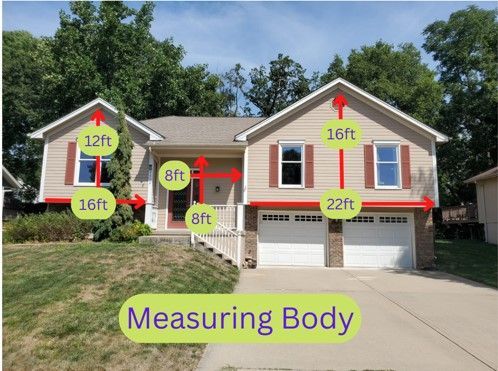
How to measure the body of a house
We refer to a house's body as its majority. For example, it could be clapboard, stucco, brick, LP SmartSide siding, Hardi Board siding, or beveled cedar. It’s what’s most likely to go through the biggest transformation after being painted and the biggest cost factor in a full exterior paint job.
Our measurement process for houses is very simple. During the measurement, we measure both the length and height of the home. The process is repeated all the way around the house. We adjust for stone or brick that is not being painted. We want to get as close as possible to knowing the number of square feet of the areas that will be painted. A total square footage measurement can be obtained by measuring all four sides of the house.
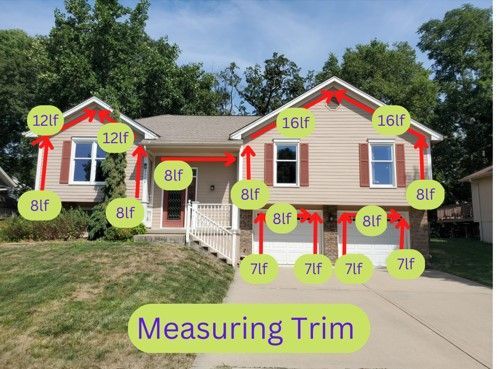
How to measure the trim of a house
Trim on the exterior of a house refers to the decorative and protective elements that are added to the edges and corners of the structure. It can include items such as window and door trim, corner boards, and eaves and fascia trim. These elements can be made of various materials, such as wood, vinyl, or aluminum, and painted or stained to match or complement the color of the house. The trim helps to define the architectural style of the house and can also provide added protection against weather and pests.
When calculating trim, we try to do our best to simplify things. Typically, trim is painted a contrasting color. We will measure trim that is NOT attached to a window, door, pillar, columns, or vents in lineal feet. This means we are measuring fascia’s, soffit overhangs, rakes, and similar.
As much as we are trying to achieve accuracy, we also don’t want to nickel and dime our customers by trying to measure out each painted window trim, door trim, window sashes, and air vents. In these instances, we just charge by the actual number. If there’s 6 windows trimmed out in the front, then we will add the quantities up and calculate at 6 each. If there’s 3 entry doors with trimmed-out door casings, then we would calculate as 3 each.
Window Trim
— Most houses have the front window trim painted a trim color to provide some contrast. Only a small percentage of homes have window trim painted all around the entire house. Most homeowners reading this information right now cannot recall if all their window trim is painted or not. When we do the estimating, we base it on what we actually see-UNLESS the owner tells us otherwise.
Miscellaneous — The square footage of the trim is typically increased by the square footage of miscellaneous items such as columns, railings, and porch ceilings. We mentioned that trim gets counted as lineal feet but in our world a lineal foot is the equivalent of a square foot. The linear trim footage would be increased by approximately 24 square feet if you have railings that are 4ft high and 6ft long.

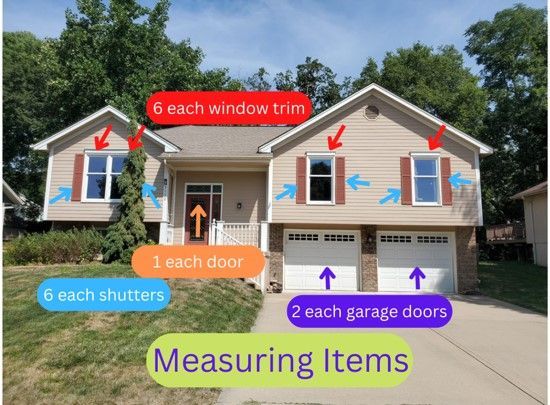
How to count everything else - the 'items'
Every house will have a body and trim to paint but after that things must be customized to the homeowners’ preferences. This is where even though two houses could be the same size and style the following areas can make a significant difference in the final price.
Entry Doors — Some owners want them painted and some have no need because the door just doesn’t require it. Most houses have a front and back entry door while some could have 4 or more.
Window Sashes — It is the sashes that you open and close that are the actual windows (not the trim or storm windows). It's just a matter of counting them up and charging for each one to be painted. In some cases, windows have grids (called mullions), which make painting them more challenging.
Shutters — Many people do not have shutters on their windows. Some houses may only have 4 while others may have 24. Obviously, the more shutters you want painted the higher the final price.
Gutters & Downspouts — The cost of gutters and downspouts is generally lumped together, regardless of whether they are painted. It’s easier for the crews to go ahead and paint, plus they will look new. If they don’t get painted, then it requires extensive masking and/or labor to be extra cautious not to get fresh paint on them.
Garage Doors — Some owners want them painted, while others don’t care for it. We’ve come across instances where a house had 6 garage doors. Obviously, the more that get painted the higher the final price.
Foundations — If a house's foundation has already been painted, you may as well paint it again. Unless you have high foundation walls (like more than 2 feet high), we just do a lump sum and don’t worry about measuring them out.
Supplies — We consider supplies such as masking tape, masking plastic, masking paper, shields, tarps, garbage bags, and primers. There is good adhesive orange tape and standard yellow tape. There’s good masking plastic and there’s cheap masking plastic. Over the years, we've learned that buying cheap things doesn't pay off. For that reason, we don’t skimp on supplies.
Caulking
— Painting the exterior requires caulking, which is one of the most critical parts of the process. Skim on the quality of the caulk and it will eventually cause problems. We use the 2nd best residential caulk that Sherwin Williams makes. Caulking is used to keep water/moisture out and makes things aesthetically pleasing to the eye.
How much does it cost for each category?
How much does it cost to paint the body?
In 2023, the cost of painting the body of the house will range from $0.85 to $1.50 per square foot (sf).
In the above example, total square footage of all four sides comes out to 3,400 square feet. Painting the
body of this house would cost $2,890 to $4,250.
How much does it cost to paint the trim?
The unit price to paint the actual trim (excludes window and door trim, railings, porch soffits) will range from $1.00 to $1.50 per square foot (sf).
In the above example, the total lineal footage of our trim is 250 linear feet (lf) of all 4 sides (some houses do have trim on all 4 sides). That means, to paint the linear trim of the entire house, would be from $263 to $388 (excluding windows, doors, railings and porch soffits).
Window Trim — Unit prices range from $40 to $50 each to paint a standard window trim. Let’s say that there are 6 window trims that need to be painted. This means the total price range for window trim comes out to $240 to $300.
Miscellaneous — The trim footage referenced above would be increased by approximately 24 square feet if you have railings that are 4ft high and 6ft long. It would cost $1.00 to $1.50 per square foot. At 24 square feet, the cost for miscellaneous trim
is between $24 to $36.
How much does it cost to paint the items?
Entry Doors — The unit price to paint an entry door ranges from $90 to $115 each. In this case, let’s assume we are painting the front entry door and the back entry door. The price range for painting doors would be $180 to $230.
Window Sashes — Unit pricing for window sashes ranges from $30 to $40. The cost of painting 6 window sashes on a home would range from $180 to $240.
Shutters — Depending on the shutter type, shutter painting can cost anywhere from $45 to $55 each. Our pictured house has 6 shutters. The total price range for shutters comes out to $270 to $330.
Gutters & Downspouts — Instead of going out to measure gutters, we make the price a lump sum amount. The total estimated price range for gutters would be $75 to $150. The difference would be if you have gutters on two different levels.
Garage Doors — The unit price to paint garage doors is $80 to $95 each. Let’s assume there are only 2 garage doors. The total estimated price for garage doors comes out at $160 to $190.
Foundations — The unit price for painting foundations ranges from $125 to $175. We charge a lump sum instead of measuring them out.
Supplies — The more surfaces we need to mask off (windows, decks, patios, roofs, etc.) the more supplies we will need. To simplify things, we charge $0.09 per square foot, based on the square footage being painted. Taking a 3,400 square foot home as an example, the total amount for supplies would be $306.
Caulking
— To keep things simple, we charge a per unit price of $0.10 per square foot, based on the square footage being painted. This price includes caulk and labor. For a 3,400 square foot house, the total cost of caulking would come out to $340.
Summarizing All Costs -The Grand Total
We'll use the figures provided above, for our sample house, and add up the total cost for a full exterior paint project.
For our sample home, the low-end cost would be $4,878 total and, on the high-end, $7,110.
All the information we have provided here is dynamic meaning it can change depending on the complexity of a home. Most projects fall somewhere in the middle of these ranges based on the different grades of paint that we offer.
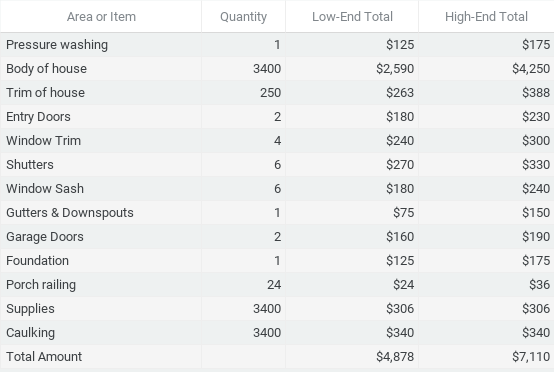
Last, but definitely not least - The Warranty
There is no doubt that price matters (it's not the only consideration, but it's still an important one). Last but not least is the warranty behind the work. Sure, you may come across a cheaper paint job but how much does it actually cost you for each year of warranty support?
If we divide $4,878 by 5, we come up with $976 (at the low end). This is how much you're investing in warranty coverage each year. When you compare that to another quote of $3,878 with a 2-year warranty, you are paying $1,939 for each year of coverage ($3,878 divided by 2). What’s the best long-term value??
We hope to have provided you with a better understanding of the potential costs of painting the exterior of your house. We are happy to provide you with a firm fixed price for your next painting project.
Schedule Your No-Obligation, No-Pressure Estimate Today!
HERE IS WHY WE ARE THE BEST CHOICE:
We know painting the exterior of your house is a huge deal. That's why you don't pay until the work is completed.
We have a proven record of performing good work. Click here to check out our Google Reviews.
We are a local company Veteran owned and run. Your support stays in our community and not to some franchise corporation in another state.
We are licensed, insured, and aren't afraid to come visit our project a year later.
We are so confident in our workmanship that we offer a 5 year standard warranty. This is best in our area.
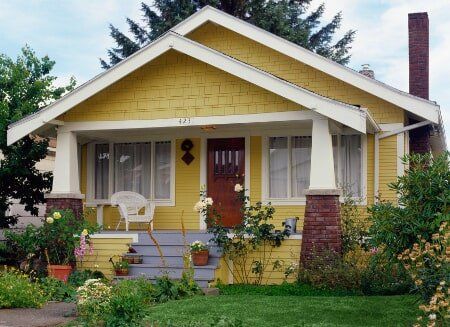
HOURS OF OPERATION
Sunday CLOSED
Monday 9:00 AM - 5:30 PM
Tuesday 9:00 AM - 5:30 PM
Wednesday 9:00 AM - 5:30 PM
Thursday 9:00 AM - 5:30 PM
Friday 9:00 AM - 5:30 PM
Saturday CLOSED
We Read E-Mails After Hours
And Weekends









